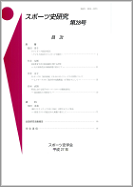The purpose of this paper is to clarify how complex relationships between judo organizations and
groups in France changed after World War II. This paper focuses on the correlations between the
internal situations of judo in France, and the tendencies outside of France.
The first judo federation in France was the FFJJ, which existed from 1946 to 1956. The number of
Judoka rapidly increased in France after WWII because of the Me´thode Kawaishi, an original judo
method invented by Mikinosuke Kawaishi. The Me´thode Kawaishi was adapted by the FFJJ as the
official method. The centralized governance system of this method can be credited for the successful
production of judo professors as well as the creation of judo clubs.
However, Shudokan Club and its professors were opposed to the FFJJ as they espoused the Kodokan Judo method by Ichiro Abe, rather than the Me´thode Kawaishi. Abe influenced the rise of adherents of Kodokan judo in France. They were called “tendence Kodokan”. They opposed the technical policy and the ethical characteristics of the FFJJ, and established their own federal organization
in 1954. This federation showed their confrontational attitude towards the FFJJ, which resulted in
the FFJJ attempting to exclude “tendence Kodokan” at first. This decisive conflict between the FFJJ
and Kodokan spread across the country. Ultimately, both groups concluded with an agreement for
their unification. A new federation, la Fe´de´ration Française de Judo et Disciplines Assimile´es(FFJDA) was established in 1956.
In the international scene, the International Judo Federation was established in 1951, with the
first World Judo Championship being held in 1956. Moreover, the movement by the IJF to include
judo into the Olympic program started immediately after WWII. Thus, the period of dynamic international changes surrounding judo, and the period from the end of WWII to the foundation of
FFJDA overlapped with each other.
The FFJJ actively worked to retain hegemony over international judo after WWII. In order to
take the initiative within the IJF, and to facilitate the inclusion of judo in the Olympic Games, the
FFJJ approached Japan despite the view against “tendence Kodokan” in France. The more actively
the FFJJ worked with the IJF, the more the differences between the national situation and the international attitude stood out. The FFJJ attempted to integrate with “tendence Kodokan” by making concessions in order to resolve the conflicting situation.
View full abstract
